

This layer is concerned with the physical operation of the storage device (e.g. The third layer is the physical file system. "This interface allows support for multiple concurrent instances of physical file systems, each of which is called a file system implementation". The second optional layer is the virtual file system. This layer provides "file access, directory operations, security and protection". The logical file system "manage open file table entries and per-process file descriptors".

It provides the application program interface (API) for file operations - OPEN, CLOSE, READ, etc., and passes the requested operation to the layer below it for processing. The logical file system is responsible for interaction with the user application. Sometimes the layers are explicitly separated, and sometimes the functions are combined.

Architecture Ī file system consists of two or three layers. By 1961, the term was being applied to computerized filing alongside the original meaning.
:max_bytes(150000):strip_icc()/how-to-convert-flac-to-mp3-50719612-5aa2a02a189f45cd9f1da6d789dee56e.jpg)
Does switch audio converter for android have file leveling iso#
For example, the ISO 9660 file system is designed specifically for optical discs.įile systems can be used on numerous different types of storage devices that use different kinds of media. Some file systems have been designed to be used for specific applications. Each one has different structure and logic, properties of speed, flexibility, security, size and more. There are many different kinds of file systems. Taking its name from the way a paper-based data management system is named, each group of data is called a " file." The structure and logic rules used to manage the groups of data and their names is called a "file system." By separating the data into pieces and giving each piece a name, the data is easily isolated and identified. Without a file system, data placed in a storage medium would be one large body of data with no way to tell where one piece of data stopped and the next began, or where any piece of data was located when it was time to retrieve it. In computing, file system or filesystem (often abbreviated to fs) is a method and data structure that the operating system uses to control how data is stored and retrieved.


 0 kommentar(er)
0 kommentar(er)
